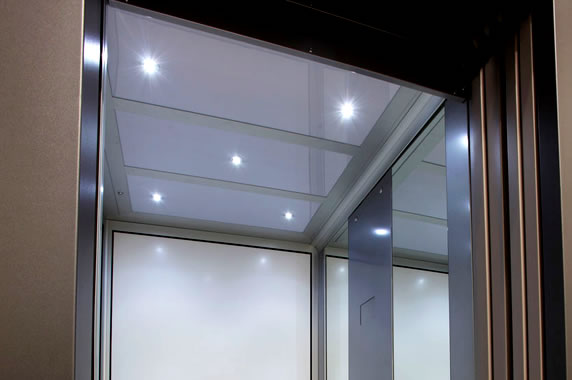
Simple elevator upgrades, like LED lighting with automatic shut-off, will help a building’s energy consumption to decrease. Easily retrofitted, LED elevator lamps provide equivalent light output and color quality while using 85% less energy and lasting 12 times longer than halogen R12 lamps.
Elevators in high-rise buildings carry an immense amount of traffic for long distances throughout a typical day. Efficiency – through optimized energy usage, maintenance, and even design – can lead to substantial savings in both operational costs and riders’ time.
Elevators and Energy
All elevators use energy. Although levels of energy efficiency may vary among different models, a majority of new elevators make up a small percentage (generally assumed to be two to three percent) of a building’s overall energy consumption. The energy efficiency of elevators has greatly improved in parallel with technological advances in motor controls. Due to the increasing number of drive technologies created over the last three decades, units manufactured more than 20 to 30 years ago are significantly less energy efficient than today’s newer models.
Traction elevators that are more than 20 years old require the use of DC (direct current) hoist motors. These DC hoist motors need a motor generator in order to convert AC (alternating current) power into DC power. The necessity of power conversion is due to the AC motor’s inability to provide a precision control on the elevators acceleration and deceleration, which affects ride quality. Over time, manufacturers developed new technologies to convert AC power directly to DC power through SCR (silicon-control rectifiers) drives. SCR drives enable building owners to remove the redundant secondary motor generator that simply converts power from AC to DC.
This elimination has reduced the need for dual motors, leading to significant reductions in energy use and operating costs, and shrinking space requirements in the machine room.
Expenses associated with creating a more energy-efficient elevator system range from minor upgrades such as lighting improvements to a complete energy efficient system design and installation. Simple elevator upgrades, like LED lighting, closed-loop door operators or automatic fan and light shut-off, help a building’s energy consumption to decrease. This ensures building owners save money each year. Energy-efficient lighting, controls and improved ride and air quality (IAQ) will also benefit building owners through improved tenant attraction and retention.
Destination Control Software
The use of destination control software can create up to 35 percent more efficient passenger transportation compared to standard elevator control, and increases handling capacity (e.g., the number of people an elevator can transport efficiently in a set time). Grouping elevators by destination improves routing and enables fewer cars to take fewer trips. In the long run, destination control systems can even increase overall property value.
Passengers do not see traditional floor buttons inside the elevator. Instead, they use the touch screen in the lobby to register the floor to which they are traveling. The touch screen will graphically (and audibly) direct each passenger to the appropriate elevator for his or her destination. Guided by a formula based on estimated time to destination, the system takes into account each person’s desired stop and dispatches the elevator that will provide the fastest trip time for all passengers.
Once the elevator arrives, indicators direct passengers to their appropriate ride. The destination control software increases passenger-handling capacity, accommodating high traffic needs. Instead of stopping at multiple floors for different individuals, the dispatch system groups passengers traveling to similar floor destinations, thus reducing the number of stops for each elevator.
Remote Monitoring
Elevators running at peak performance use less energy. To maximize the performance and safety of elevator products, a code-compliant preventive maintenance program is important.
Remote monitoring is an innovative service feature for control systems that monitors the performance of an elevator at all times. These systems provide real-time progress reports that can be enabled and viewed at any time and from anywhere. The advanced notification also helps reduce unnecessary service calls to the site and can eliminate unneeded paperwork. If something out of the ordinary were to occur, or if the elevator was not performing optimally, the monitoring system would alert the service provider, sometimes before a problem is even exposed to the facility managers, thus ensuring timely adjustments and repair and minimizing costly elevator down time.
A Need for Speed (and Comfort)
The sheer number of floors in the tallest high rises necessitates some additional attention to speed, while maintaining rider comfort and safety. The use of innovative technologies can be key in both areas.
- Ride quality – Active roller guides minimize vibrations and create a smoother ride.
- Aerodynamics – Custom engineered shrouds can deflect the air and improve an elevator’s aerodynamics.
- Sound suppression – Acoustic dampening in cab shells and doors can help to limit noise, increasing rider comfort.
- Speed control – An anonometer that measures wind speed and “talks” to the elevator controller can adjust the cab’s speed so the normal building movement during windy days does not affect elevator operation.
With energy consumption and focus on the bottom line reaching an all-time high, builders and property managers alike are looking for the most efficient operations possible. Whether customers are upgrading their current system or installing a new elevator, the latest technology in vertical offers benefits for building owners and occupants.
Originally published January 1, 2013
Sasha Bailey, LEED AP BD+C
Sasha Bailey, LEED AP BD+C is the Strategic Communications Manager for ThyssenKrupp Elevator Americas. Email her at [email protected]. ThyssenKrupp Elevator Americas has been involved with some of the highest profile high rises in North America, including One World Trade Center in New York, Toronto's Shangri-La Hotel, and the Great American Tower (Cincinnati's tallest building), among others.

